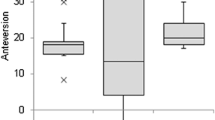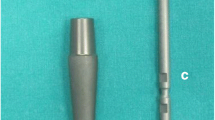Abstract
Background
Total hip replacement has been advocated for the treatment of degenerative hip diseases secondary to slipped capital femoral epiphysis; nonetheless, outcomes of this procedure have not been well established. We reviewed the outcomes of modern total hip replacements in patients who suffered from slipped capital femoral epiphysis.
Methods
A retrospective study was carried out on 32 total hip replacements performed on 28 patients who suffered from slipped capital femoral epiphysis from August 1994 to January 2007. The average age at the time of surgery was 45 years. Clinical evaluation was performed using the Harris Hip Score, radiographic assessment measuring cup and stem orientation, the extent of osteolysis around the implant, and leg length discrepancy. The average follow-up was 98 months (range 25–204 months).
Results
Two total hip replacements failed, one for stem aseptic loosening and the other for modular neck failure. The cumulative survival rate at 9 years was 92.8 %. If the end point was revision for implant loosening, the survival rate improved to 96.8 % at 9 years. The only complication recorded was an intraoperative fracture of the lesser trochanter immediately treated with cerclage wire. At the latest follow-up, the Harris Hip Score averaged 86 (range 70–97). Leg length discrepancies greater than 1 cm were present in 18 cases before surgery, and in only 6 cases after surgery.
Discussion
We recommend total hip replacement for patients who suffer from slipped capital femoral epiphysis because of the satisfactory survival, low complication rate, and the possibility of restoring leg length.







Similar content being viewed by others
References
Lehmann CL, Arons RR, Loder RT, Vitale MG (2006) The epidemiology of slipped capital femoral epiphysis: an update. J Pediatr Orthop 26(3):286–290
Murray AW, Wilson NI (2008) Changing incidence of slipped capital femoral epiphysis: a relationship with obesity? J Bone Joint Surg Br 90(1):92–94
Slongo T, Kakaty D, Krause F, Ziebarth K (2010) Treatment of slipped capital femoral epiphysis with a modified Dunn procedure. J Bone Joint Surg Am 92(18):2898–2908
Leunig M, Casillas MM, Hamlet M, Hersche O, Notzli H, Slongo T, Ganz R (2000) Slipped capital femoral epiphysis: early mechanical damage to the acetabular cartilage by a prominent femoral metaphysis. Acta Orthop Scand 71(4):370–375
Fraitzl CR, Kafer W, Nelitz M, Reichel H (2007) Radiological evidence of femoroacetabular impingement in mild slipped capital femoral epiphysis: a mean follow-up of 14.4 years after pinning in situ. J Bone Joint Surg Br 89(12):1592–1596
Gent E, Clarke NM (2004) Joint replacement for sequelae of childhood hip disorders. J Pediatr Orthop 24(2):235–240
Amstutz HC, Su EP, Le Duff MJ (2005) Surface arthroplasty in young patients with hip arthritis secondary to childhood disorders. Orthop Clin North Am 36(2):223–230
Larson AN, McIntosh AL, Trousdale RT, Lewallen DG (2010) Avascular necrosis: most common indication for hip arthroplasty in patients with slipped capital femoral epiphysis. J Pediatr Orthop 30(8):767–773
Abraham E, Gonzalez MH, Pratap S, Amirouche F, Atluri P, Simon P (2007) Clinical implications of anatomical wear characteristics in slipped capital femoral epiphysis and primary osteoarthritis. J Pediatr Orthop 27(7):788–795
Radl R, Hungerford M, Materna W, Rehak P, Windhager R (2005) Higher failure rate and stem migration of an uncemented femoral component in patients with femoral head osteonecrosis than in patients with osteoarthrosis. Acta Orthop 76(1):49–55
Yasunaga Y, Yamasaki T, Matsuo T, Yoshida T, Oshima S, Hori J, Yamasaki K, Ochi M (2011) Clinical and radiographical results of 179 thrust plate hip prostheses: 5–14 years follow-up study. Arch Orthop Trauma Surg (Epub ahead of print)
Kawasaki M, Hasegawa Y, Sakano S, Masui T, Ishiguro N (2005) Total hip arthroplasty after failed transtrochanteric rotational osteotomy for avascular necrosis of the femoral head. J Arthroplast 20(5):574–579
Makela KT, Eskelinen A, Pulkkinen P, Paavolainen P, Remes V (2008) Total hip arthroplasty for primary osteoarthritis in patients fifty-five years of age or older. An analysis of the Finnish arthroplasty registry. J Bone Joint Surg Am 90(10):2160–2170
Harris WH (1969) Traumatic arthritis of the hip after dislocation and acetabular fractures: treatment by mold arthroplasty. An end-result study using a new method of result evaluation. J Bone Joint Surg Am 51(4):737–755
Herrlin K, Pettersson H, Selvik G (1988) Comparison of two- and three-dimensional methods for assessment of orientation of the total hip prosthesis. Acta Radiol 29(3):357–361
Engh CA Jr, Culpepper WJ 2nd, Engh CA (1997) Long-term results of use of the anatomic medullary locking prosthesis in total hip arthroplasty. J Bone Joint Surg Am 79(2):177–184
Engh CA, Bobyn JD, Glassman AH (1987) Porous-coated hip replacement. The factors governing bone ingrowth, stress shielding, and clinical results. J Bone Joint Surg Br 69(1):45–55
Gruen TA, McNeice GM, Amstutz HC (1979) “Modes of failure” of cemented stem-type femoral components: a radiographic analysis of loosening. Clin Orthop Relat Res 141:17–27
Brooker AF, Bowerman JW, Robinson RA, Riley LH Jr (1973) Ectopic ossification following total hip replacement. Incidence and a method of classification. J Bone Joint Surg Am 55(8):1629–1632
Atwood SA, Patten EW, Bozic KJ, Pruitt LA, Ries MD (2010) Corrosion-induced fracture of a double-modular hip prosthesis: a case report. J Bone Joint Surg Am 92(6):1522–1525
Wright G, Sporer S, Urban R, Jacobs J (2010) Fracture of a modular femoral neck after total hip arthroplasty: a case report. J Bone Joint Surg Am 92(6):1518–1521
Traina F, De Clerico M, Biondi F, Pilla F, Tassinari E, Toni A (2009) Sex differences in hip morphology: is stem modularity effective for total hip replacement? J Bone Joint Surg Am 91(Suppl 6):121–128
Lewinnek GE, Lewis JL, Tarr R, Compere CL, Zimmerman JR (1978) Dislocations after total hip-replacement arthroplasties. J Bone Joint Surg Am 60(2):217–220
Johannson HR, Zywiel MG, Marker DR, Jones LC, McGrath MS, Mont MA (2011) Osteonecrosis is not a predictor of poor outcomes in primary total hip arthroplasty: a systematic literature review. Int Orthop 35(4):465–473
Baek SH, Kim SY (2008) Cementless total hip arthroplasty with alumina bearings in patients younger than fifty with femoral head osteonecrosis. J Bone Joint Surg Am 90(6):1314–1320
Kim YH, Choi Y, Kim JS (2010) Cementless total hip arthroplasty with ceramic-on-ceramic bearing in patients younger than 45 years with femoral-head osteonecrosis. Int Orthop 34(8):1123–1127
Thillemann TM, Pedersen AB, Johnsen SP, Soballe K (2008) Implant survival after primary total hip arthroplasty due to childhood hip disorders: results from the Danish Hip Arthroplasty Registry. Acta Orthop 79(6):769–776
Amstutz HC, Ebramzadeh E, Sarkany A, Le Duff M, Rude R (2004) Preservation of bone mineral density of the proximal femur following hemisurface arthroplasty. Orthopedics 27(12):1266–1271
Kishida Y, Sugano N, Nishii T, Miki H, Yamaguchi K, Yoshikawa H (2004) Preservation of the bone mineral density of the femur after surface replacement of the hip. J Bone Joint Surg Br 86(2):185–189
Bartoníček J, Vávra J, Bartoška R (2011) Operative treatment of avascular necrosis of the femoral head after slipped capital femoral epiphysis. Arch Orthop Trauma Surg 131(4):497–502
Acknowledgments
The authors wish to thank Luigi Lena for his help in the release of this work.
Conflict of interest
The authors declare that they have no conflict of interest.
Author information
Authors and Affiliations
Corresponding author
Rights and permissions
About this article
Cite this article
Traina, F., De Fine, M., Abati, C.N. et al. Outcomes of total hip replacement in patients with slipped capital femoral epiphysis. Arch Orthop Trauma Surg 132, 1133–1139 (2012). https://doi.org/10.1007/s00402-012-1538-z
Received:
Published:
Issue Date:
DOI: https://doi.org/10.1007/s00402-012-1538-z




